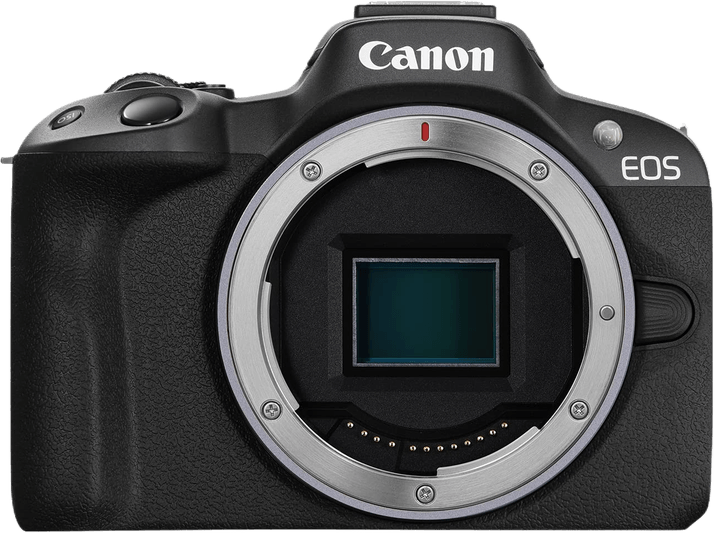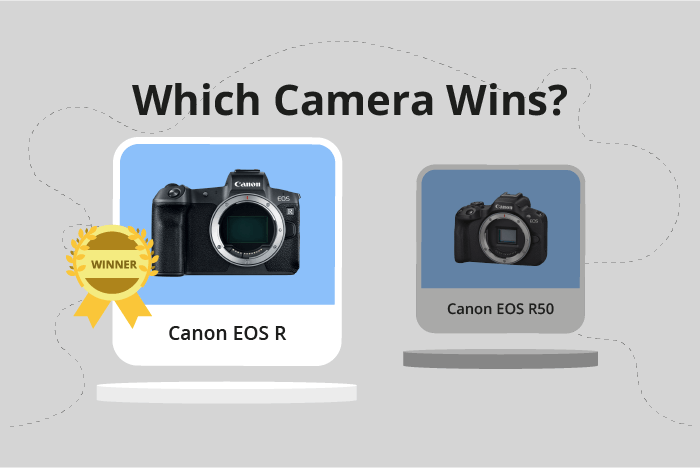Canon EOS R vs EOS R50 Comparison
Canon EOS R

Canon EOS R50

The Canon EOS R outperforms the Canon EOS R50 with a score of 74/100 compared to 70/100. Both cameras are mirrorless and share similar specifications, such as announcement dates and release years (2018 for the EOS R and 2023 for the EOS R50).
The EOS R excels with its larger size (136 x 98 x 84mm) and heavier weight (485g / 1.07lbs), which may provide better stability and handling for some users. Its higher launch price of $2300 also suggests more advanced features and better overall performance.
On the other hand, the EOS R50 is more compact (116 x 86 x 69mm) and lighter (375g / 0.83lbs), making it a more portable option. Additionally, its lower launch price of $679 makes it a more budget-friendly choice.
Taking these factors into account, the Canon EOS R is the better camera due to its higher score, while the EOS R50 offers a more affordable and portable alternative for those who prioritize these aspects.
Canon EOS R vs EOS R50 Overview and Optics
The Canon EOS R and the Canon EOS R50 both receive an optics score of 73/100. These cameras share common features such as CMOS sensor type, Canon RF lens mount, and lack of image stabilization.
The Canon EOS R has a higher megapixel count at 30.3, compared to the EOS R50’s 24 megapixels. This difference allows the EOS R to capture more detail in images. Additionally, the EOS R has a full-frame sensor, which provides a larger field of view and better low-light performance than the R50’s APS-C sensor. The EOS R’s DXOMARK score for the sensor is 89, slightly lower than the R50’s 94.
On the other hand, the Canon EOS R50 has a faster shooting speed of 12 frames per second compared to the EOS R’s 8 frames per second. This enables the R50 to capture fast-moving subjects more effectively. Furthermore, the R50’s Digic X processor provides faster image processing and better overall performance compared to the EOS R’s Digic 8 processor.
In terms of optics, the Canon EOS R excels with its higher megapixel count and full-frame sensor. These features make it ideal for photographers seeking high-resolution images and improved low-light performance. Conversely, the Canon EOS R50 offers a faster shooting speed and a more advanced processor, making it suitable for action photography and those requiring speedy performance.
Both cameras have their strengths and weaknesses, but their equal optics score indicates that each model has its own unique advantages. Ultimately, the choice between the Canon EOS R and the Canon EOS R50 depends on the specific needs and preferences of the photographer.
Canon EOS R vs EOS R50 Video Performance
The Canon EOS R50 outperforms the Canon EOS R in video capabilities, with a video score of 91/100 compared to the EOS R’s 70/100. Both cameras share some common specifications, such as 4K maximum video resolution and 3840 x 2160 maximum video dimensions. Additionally, both cameras have built-in time-lapse functionality.
The EOS R50’s superiority in video performance is evident in its maximum video frame rate of 120fps, which is significantly higher than the EOS R’s 30fps. This higher frame rate allows for smoother and more detailed slow-motion footage, making the EOS R50 a better choice for videographers who require high-quality slow-motion capabilities.
While the EOS R does not surpass the EOS R50 in any specific video capability, it still offers a decent video performance with its 4K resolution and built-in time-lapse functionality. This makes the EOS R a suitable option for those who prioritize photography but still need occasional video capabilities.
Comparing the two cameras, the Canon EOS R50 is the clear winner in terms of video performance due to its higher video score and superior frame rate. The EOS R50 is an excellent choice for videographers who require advanced slow-motion capabilities, while the EOS R remains a viable option for photographers with occasional video needs.
Canon EOS R vs EOS R50 Features and Benefits
The Canon EOS R outperforms the Canon EOS R50 with a feature score of 87/100, compared to the R50’s 72/100. Both cameras share several features, including a touchscreen, flip screen, Wi-Fi, and Bluetooth connectivity. However, neither camera has GPS functionality.
The EOS R takes the lead with a larger screen size of 3.2 inches and a higher screen resolution of 2,100,000 dots. This provides the user with a clearer and more detailed view of their images when composing and reviewing shots. The superior screen quality of the EOS R contributes significantly to its higher feature score.
On the other hand, the EOS R50 has a slightly smaller screen size of 3 inches and a lower screen resolution of 1,620,000 dots. While these differences may not be drastic, they do impact the user experience, making the EOS R50 less preferable in terms of screen specifications.
Despite the lower feature score, the EOS R50 still offers a decent user experience with its touchscreen and flip screen capabilities, along with Wi-Fi and Bluetooth connectivity. These features are valuable for photographers who prioritize ease of use and seamless connectivity.
To sum up, the Canon EOS R is the superior camera in terms of features, primarily due to its larger screen size and higher screen resolution. The EOS R50, while not as impressive, still offers a respectable array of features that cater to users who prioritize simplicity and connectivity.
Canon EOS R vs EOS R50 Storage and Battery
The Canon EOS R and the Canon EOS R50 have identical storage and battery scores, both receiving 35/100. Both cameras have one memory card slot and accept SD, SDHC, and SDXC cards. They also have the same battery life of 370 shots and offer USB charging capabilities.
The Canon EOS R50 has a slight advantage in memory card compatibility, as it supports both UHS-I and II, while the Canon EOS R only supports UHS-II. This difference allows the EOS R50 to work with a broader range of memory cards, providing more flexibility for users.
On the other hand, the Canon EOS R uses the LP-E6N battery type, while the Canon EOS R50 uses the LP-E17. There is no significant advantage for either camera in terms of battery type.
Given these similarities and minor differences, both cameras perform equally well when it comes to storage and battery. Users can confidently choose either camera without compromising on storage and battery performance.
Canon EOS R vs EOS R50 – Our Verdict
Are you still undecided about which camera is right for you? Have a look at these popular comparisons that feature the Canon EOS R or the Canon EOS R50:

